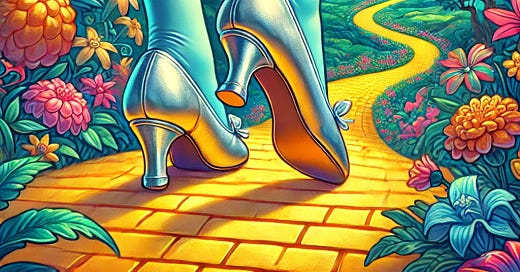If you mention the Wizard of Oz to someone, they will most likely recognize it. No matter the age, it was a classic that stood the test of time and became one of the most nostalgic movies ever produced. However, most people need to learn about the allegory’s hidden meaning. Before the movie was released in 1939, it was a children’s book written by L. Frank Baum in 1900 amid political strife. Decoding The Wizard Of Oz and all the symbolism intertwined and unveiling what was behind the curtain will be the objective. The narrative of The Wizard of Oz reflects a shared ethos of advocating for the common man against larger oppressive forces. When the book was written, the gold standard was used as a monetary means. William Jennings Bryan was running for President then and gave a profound speech that became one of the most famous speeches in history: the Cross of Gold speech. He advocated that the common man, farmers, laborers, and small business owners were just as important as the financial magnates. He wanted to use bimetallism, which would use silver and gold, to counteract the deflation due to the production of gold not keeping up with GDP. His solution was that if physical silver were implemented at a fixed ratio to gold, it would cause healthy inflation, and farmers could afford to repay their loans. There are too many analogies to keep up with, so to avoid confusion, let's not get stuck reflecting on the trivial stuff. One significant analogy that must be discussed is that the shoes Dorthy wore in the movie were ruby red, but the shoes she wore in the book were silver. The shoes symbolized physical silver, so there was a direct correlation. The imagery of silver slippers over a yellow or “gold” brick road reflects Bryan’s advocacy for the free coinage of silver, leveraging America’s vast silver reserves to empower the average citizen against the restrictive gold standard. Since America had 50% of the world’s supply of silver at the time, it made sense to peg the dollar to silver. What are gold and silver measured in? That’s right, ounces or “oz.” The emerald city? That’s green cash. Showing Dorothy walking on a yellow brick road in silver slippers tells the reader that silver triumphs over gold regarding what’s best for America’s currency. Jennings wanted the people to all have a level playing field, and that meant instead of the trickle-down effect, he would advocate for the bottom-up impact, which gave the lower-class people a chance to lead a better standard of life.
Scarecrow
Symbolism: The Scarecrow represents American farmers, particularly those in the Midwest. He embodies both the perceived lack of intelligence and the actual wisdom of farmers, highlighting their struggles with the environment, economy, and government. His quest for a brain symbolizes the need for knowledge and empowerment.
Tin Man
Symbolism: The Tin Man symbolizes industrial workers, specifically steelworkers. He represents the dehumanization and struggles of laborers in the industrial age, particularly those affected by events like the 1892 Homestead Strike. His desire for a heart reflects the need for compassion and humanity in industrial work.
Cowardly Lion
Symbolism: The Cowardly Lion represents William Jennings Bryan, a prominent politician known for his populist views and oratory skills but perceived as lacking the courage to act decisively. The Lion's quest for courage symbolizes the need for bravery and conviction in leadership.
Wicked Witch of the West
Symbolism: The Wicked Witch of the West represents various negative forces, including fear, danger, and corruption. She can also symbolize the harshness of nature, oppressive political figures, and the corporate ruling class. Her defeat by water underscores the vulnerability of these seemingly powerful entities.
Glinda the Good Witch
Symbolism: Glinda represents the positive, guiding forces in life. In some interpretations, she symbolizes the exotic glamor of Oz that Dorothy ultimately rejects in favor of home. She also represents the benevolent aspects of power and protection.
The Wizard
Symbolism: The Wizard represents the President of the United States or political leaders in general. He symbolizes the illusion of power and authority, as his grandiose persona is revealed as a facade, highlighting the often deceptive nature of political power.
Munchkins
Symbolism: The Munchkins represent ordinary citizens or marginalized groups, including poor workers and immigrants. They symbolize the common folk often oppressed and overlooked by those in power.
Winged Monkeys
Symbolism: The Winged Monkeys symbolize exploited workers, such as Native Americans or Asian railroad workers, who are used by those in power for their unique skills and numbers.
Yellow Brick Road
Symbolism: The Yellow Brick Road represents the gold standard, a significant economic issue of the time. It symbolizes the path to enlightenment and transformation, guiding Dorothy and her companions to their ultimate goals.
Emerald City
Symbolism: The Emerald City represents Washington, D.C., and the seat of political power. Its green color symbolizes the greenback dollar and the illusion of prosperity and power.
These symbolic interpretations provide a rich layer of meaning to "The Wizard of Oz," reflecting both the characters’ struggles and the broader political and social issues of the time.




